Casca Wines
by
Terry Sullivan
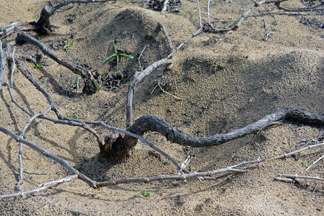 Summary: Casca Wines produces a wide variety of wines crafted with grapes from several of Portugal’s wine regions. They are a group of winemakers who work with growers throughout Portugal. This article will concentrate on the Coleras region, north of Lisbon, where unique growing conditions challenge the wine grape growers.
Summary: Casca Wines produces a wide variety of wines crafted with grapes from several of Portugal’s wine regions. They are a group of winemakers who work with growers throughout Portugal. This article will concentrate on the Coleras region, north of Lisbon, where unique growing conditions challenge the wine grape growers.
Casca Wines is a company of winemakers that formed in 2008. The same winemaking team works with unique grape growers around the country in 13 DOC regions covering Portugal from Southern Portugal to the north. Specifically, Casca Wines works with grape growers in Alentejo, Colares, Tejo, Bairrada, Dão, Távora Varosa, Douro and Minho in Vinho Verde.
Pedro Serôdio, export manager for Casca Wines, explained, “We are showcasing wines, not driven by volume, but wines that showcase what Portugal has to offer.” The winemakers in the company work closely with over 50 grape growers. Casca Wines produces over 1,000,000 bottles of wine.
In Colares, the winemaking team works with growers who maintain 11 hectares (27 acres) of vines. Winemaker Helder Cunha, founder and co-owner of Casca Wines, took us on a tour of the vineyards near the Atlantic Ocean. Pedro stated, Helder is "the one person who envisioned the project of winemakers who, without the ownership of vineyard or estates, would work with the best grapes in Portugal from unique grapegrowers."
While viewing the vineyards, some in our group were quick to comment, “Never saw that before.” With the ocean only 100 meters from the vineyard, there are special challenges that grape growers deal with. With this close proximity to the ocean, it is windy and cool. Grapes, on traditional trellising systems, will struggle to become ripe. Today, the growers have used the growing processes from their ancestors. Wind shields are constructed to help cut down, not eliminate, the strong ocean breezes. The sandy soil heats up quickly, so the growers spread the vines on top of the sand so the vines can benefit from the sand’s stored up heat. Grapes develop a deep root system reaching up to seven meters deep. These deep roots are needed to penetrate the clay level under the sand for water and nutrients.
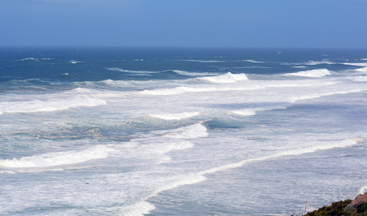 `
`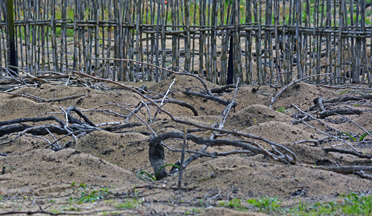
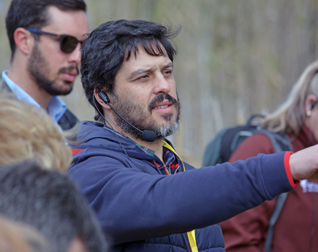 Helder (pictured left) demonstrated a process used. As grapes develop, about one foot sticks with a “V” cut out on one end are placed in the sand and the vines are positioned in the “V”. This allows some air flow below grape clusters and the berries still gain the radiating heat from the sand. The two main grapes grown in this sandy region of Coleras are the white grape Malvasia Coleras and the red grape Ramisco. Both of these grapes are suited for this terroir. We observed vines that were about 200 years old planted on their own rootstock. The sand helps to protect the vines from the Phylloxera insect. The growers receive about 3.00 € per kilogram of harvested grapes compared to an average of 0.40 € per kilogram for grapes grown elsewhere. Hopefully, this higher price will help growers keep their vineyards rather than selling their land to developers.
Helder (pictured left) demonstrated a process used. As grapes develop, about one foot sticks with a “V” cut out on one end are placed in the sand and the vines are positioned in the “V”. This allows some air flow below grape clusters and the berries still gain the radiating heat from the sand. The two main grapes grown in this sandy region of Coleras are the white grape Malvasia Coleras and the red grape Ramisco. Both of these grapes are suited for this terroir. We observed vines that were about 200 years old planted on their own rootstock. The sand helps to protect the vines from the Phylloxera insect. The growers receive about 3.00 € per kilogram of harvested grapes compared to an average of 0.40 € per kilogram for grapes grown elsewhere. Hopefully, this higher price will help growers keep their vineyards rather than selling their land to developers.
Wines
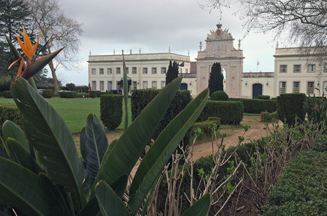 Wine tasting took place at the iconic Tivoli Hotel. We started with the two wines produced from grapes grown in sandy soils. The 2013 Monte Cascas Colares Malvasia, Colares DOC was made of Malvasia de Colares grapes. The 11.4% alcohol wine had a yellow color with a gold hue. The aroma had floral notes. The taste was reminiscent of daisies, apples and salt. The finish was predominantly floral with salt on the aftertaste. We have tasted very few wines that had a hint of salt, a profile that we like.
Wine tasting took place at the iconic Tivoli Hotel. We started with the two wines produced from grapes grown in sandy soils. The 2013 Monte Cascas Colares Malvasia, Colares DOC was made of Malvasia de Colares grapes. The 11.4% alcohol wine had a yellow color with a gold hue. The aroma had floral notes. The taste was reminiscent of daisies, apples and salt. The finish was predominantly floral with salt on the aftertaste. We have tasted very few wines that had a hint of salt, a profile that we like.
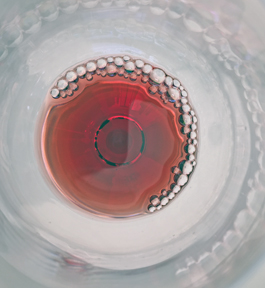 The second wine crafted with grapes grown in sandy soils was the 2011 Monte Cascas Colares Red. The wine was made from Ramisco grapes. The 10.5% alcohol wine had a translucent red color with ruby hue. The aroma offered red berry fruit. The taste included raspberries, salt and pepper. The wine had a medium body and medium tannins. The finish was crisp with the taste of raspberries, salt and pepper.
The second wine crafted with grapes grown in sandy soils was the 2011 Monte Cascas Colares Red. The wine was made from Ramisco grapes. The 10.5% alcohol wine had a translucent red color with ruby hue. The aroma offered red berry fruit. The taste included raspberries, salt and pepper. The wine had a medium body and medium tannins. The finish was crisp with the taste of raspberries, salt and pepper.
We also tasted other wines from Casca Wines’ portfolio. The 2016 Cabo da Roca Reserva Arinto, Bucelas DOC spent six months in French oak. The wine was crafted with the Arinto grape. The light yellow colored wine offered apple and pear on the aroma and taste. The fruity finish had a trace of honey on the aftertaste.
The 2015 Cabo da Roca Reserva Baga, Bairrada DOC was aged in 4,000 liter oak vats for 12 months. The wine had a translucent red color with a ruby hue. Cherry was noticed on the aroma. The taste was reminiscent of cherry, pepper and mineral. The wine was medium-bodied with medium tannins. The finish of cherries and peppers was seductive, making you want more.
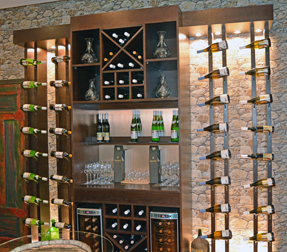 The 2010 Monte Cascas Vinha da Carpanda, Dão DOC was crafted with Jean and Touriga Nacional grapes. Black fruits were on the aroma while the taste included blackberries, blueberries and violets. The full-bodied wine had bold tannins. The finish was fruity with some spices.
The 2010 Monte Cascas Vinha da Carpanda, Dão DOC was crafted with Jean and Touriga Nacional grapes. Black fruits were on the aroma while the taste included blackberries, blueberries and violets. The full-bodied wine had bold tannins. The finish was fruity with some spices.
The Tivoli Hotel has set aside a room for the wine producers in Colares. This room highlights many of the wines produced in this region, both the Colares DOC wines and the Lisbon regional wines.
Casca Wines
R. Cruz de Popa, 2645-449 Cascais, Portugal
Article written March 2018.
